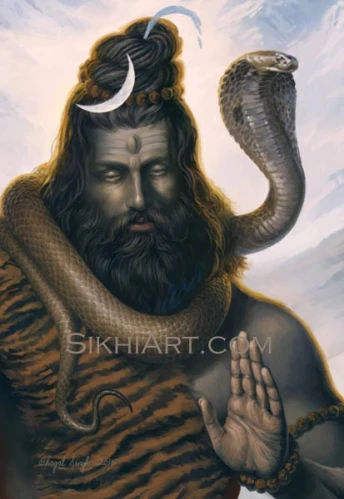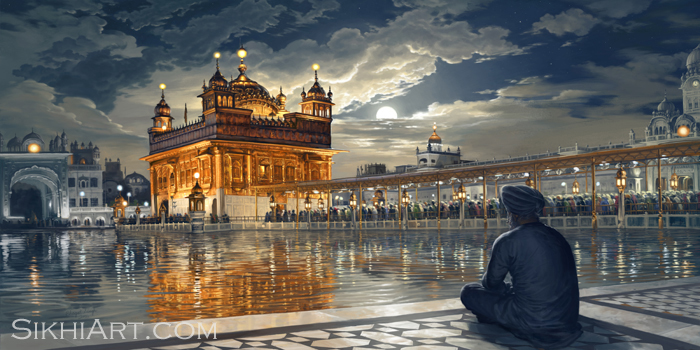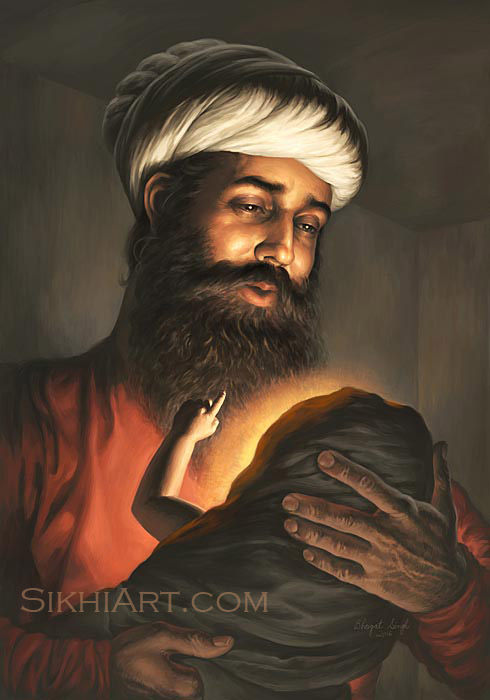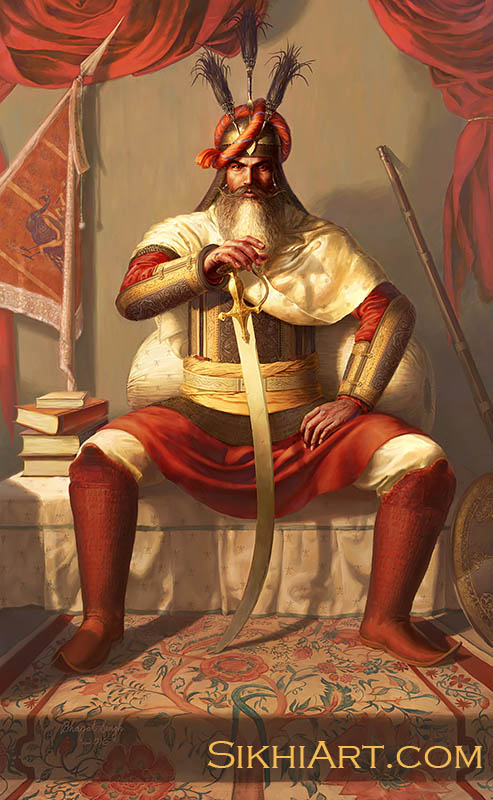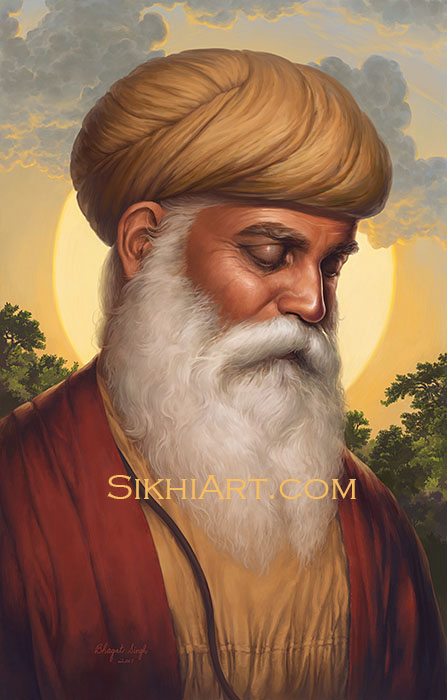Machhiwara Released
Featured Product
 Happy Vaisakhi to you all! Your support and encouraging comments are greatly appreciated!
Happy Vaisakhi to you all! Your support and encouraging comments are greatly appreciated!
Need to celebrate Vaisakhi this year with something special? You can find and purchase Baba Deep Singh ji’s posters now, at our second online store. Feel proud this Vaisakhi!
Large Poster (23″ x 35″) $22.99
Small Poster (16″ x 20″) $17.99

New Painting Released
New Painting – Guru Nanak Dev ji
You’ll be pleased to hear that we’ve just released a painting on Guru Nanak Dev ji. It depicts Guru Nanak Dev ji and Bhai Mardana ji, doing Kirtan to spread spiritual practices, moral teachings and egalitarian principles. Please contact Sikhi Art to buy this painting now.
“Men (and women) from all over the world and throughout history have been in search of pleasant sites and sounds, tastes and sensations, and attitudes. They noticed that even in the best of times, without sickness, death and horrors of old age, happiness and pleasure could only be felt temporarily by having to repeat things like eating delicious food, having professional success and celebrating festivals. Many over the ages accepted this as a fact of life, and lived their lives around reiterating this temporary relief.
However, some began to wonder whether there was a form of happiness that was not dependent on having one’s family and friends within arm’s reach, or taking all kinds of drugs…” READ MORE

Capturing the Red Fort
Bhai Baghel Singh (1730 – 1802) won over the Red Fort during the Sikh Misl period. First looting the neighbouring villages and towns, he along with other Sardars attacked the Red Fort in March of 1783. The Sardars settled on a treaty with the Emperor, collected their loot and returned to Punjab. However, Bhai Baghel Singh stayed and built gurudwaras at historical sites in Delhi, and he is remembered for carrying out this important mission.
This speed painting captures this key moment in Sikh history and celebrates Bhai Baghel Singh’s achievements.

Harimandir Sahib
What I imagine Shri Harimandir Sahib (Golden Temple) might have looked like before it was covered in gold and marble. Its humble origins are of mud and brick, surrounded only by a sacred pool (amritsar), trees and wildlife as it has yet to develop into a large urban community. These swans are the spiritually exalted gursikhs that swim in and drink from that abundant supply of amrit, which comes from the meditation of guru’s name.
Other news
Keep an eye out for my painting of Guru Arjun Dev ji. It depicts the martyrdom of Guru Sahib in meditation being tortured on a hot plate with burning sand. I am in the process of painting the final touches.
Guru Arjun Dev ji
This painting shows Guru Arjun Dev ji peacefully meditating while being tortured. Guru Sahib was made to sit on a hot plate and had hot sand poured over his head and body. Even though he was put through immense pain, he was in profound peace with the moment, with the situation he found himself in. One day while meditating on Guru Sahib’s poetry and the scene of his martyrdom, I had such a profound experience of Guru Sahib, an experience so emotionally moving and so overwhelmingly blissful that I knew I had to paint this scene.
Happy Birthday Guru Ramdas Ji!
To celebrate Guru Ramdas ji’s birthday, I have created a small, humble painting based on one of Guru Ramdas ji’s shabad. In his shabad, Guru Ramdas ji expresses the feeling of pain from being separated from Waheguru and yearning for Him with much thirst and much pain.
I wanted to capture this emotional, contemplative moment as described in the shabad below. I wanted to capture that longing in his eyes…Read More
Introducing Fantasy Paintings with ‘Akali Chief’
When Bhagat lets his imagination run loose, the result is badass warriors with hugeass turbans that look damn cool! Each painting tells its own story and a whole new universe comes into being. Inspired by Sikh aesthetics, these Fantasy Paintings are hand-painted by Bhagat, capturing years of day-dreaming in science classes.
Akali Chief – Beware the Claw
The Akali Chief leads the Akalis into battle. Not only is he covered in weapons but his turban also is a storehouse of weaponry, of claws, spiked maces, swords, daggers, arrows and cannon balls. When the Akali unleashes this hell on the battlefield, the weapons shoot out and strike nearby enemies. The ones on chains spin around and lacerate those who wish to penetrate the Chief’s defense. Continue reading…
New Painting – Banda Singh Bahadur

Newest Release
With galloping horses, kicking up dirt and debris, Baba Banda Singh ji Bahadur and his Singhs surround the cruel Wazir Khan and aim their spears at him! Wazir Khan’s horse is slain and falls to the ground, representing the fall of Sirhind, and he is forced to defend himself as he collapses to the hard ground. In the background, Baba ji’s army is Continue reading…
Upcoming Release – Celebrating Vaisakhi
Be on the lookout for my upcoming portrait of Dasam Pita, Guru Gobind Singh ji. This painting is painted in the traditional pose with Guru Sahib looking up and out into the distance, his face glowing and his expression tranquilizing. This look is combined with the accurate depiction of his turban/dumalla, plume/kalgi and robes/chola that we see in ancient paintings of Guru Gobind Singh ji of his time and of Maharaja Ranjit Singh’s time!
I will present this authentic portrait of Dashmesh Pita on Vaisakhi!
Print and Cost Structure Changes
I have been making several changes to the prints and costs in the past few weeks!
-Print changes
To make it easy to hang and to keep it simple, I have now made Stretched Premium Gloss Canvas the default option. These are of great value as we hand-stretch them around thick wooden bars to hold them taught. We also provide a hanging kit so that your canvas is ready to hang on the delivery day. This makes the hanging process hassle-free and you get to enjoy the print sooner!
Rolled canvas option is still available at a discounted cost! Especially good for those who already have the equipment necessary for stretching.
-Size changes
I have added a smaller size, 24 inches, which is more affordable for budget-conscious collectors.
This size also works well with small wall-spaces! It is also ideal for standard frames.
-International Shipping Costs
Shipping charges to United Kingdom and other International locations have always been pretty hefty for us. However I have adjusted them for you guys to make them more attractive.
Any feedback in this area is greatly appreciated. I am experimenting with these things and I will make changes or revert to old system if necessary.
Visuals
While planning to decorate my own home, I created some visuals and noticed how beautiful Harmandir Sahib would look on a pale blue wall. When I tried this with the others, they looked very refreshing. I thought this would be a great visual aid for you guys as well. So I whipped up an entire batch of such Visuals for many paintings. I will create more in the future.
Thanks for checking this out and reading all the way. Love you guys from the bottom of my heart!
New Painting of Dashmesh Pita – Happy Vaisakhi

Newest Release
My newest painting depicting Dashmesh Pita – Guru Gobind Singh ji – is a reminder that through the Guru’s teachings we can illuminate the darkness in the mind. In this painting, Dashmesh Pita reflects Akal Purakh’s light, the way the moon reflects the sun, and when we bathe in Guru Sahib’s warmth, we become warm ourselves. Continue Reading… Purchase a Print…
The above image is a very small preview of the full portrait. Guru Sahib’s larger than life personality requires a larger than life portrait!
Upcoming Paintings
I will be introducing a new work of art in a new ‘Other Faiths’ section. In addition, I have been working away on my speed-painting of Bhai Kanhaiya, to bring it to a detailed finish. Look out for these paintings in the next email!
Sikh Heritage Month Exhibition
For the whole month of April, my artwork can be seen hanging at the prestigious PAMA – Peel Art Gallery and Museum Archives. Visit – 9 Wellington Street East in Downtown Brampton to experience the paintings in person.

Thank you for your continued support. I love you guys! Have a wonderful Vaisakhi!
New Painting of Shiva
In Shaivism, Shiv ji is Mahadev, the Supreme God. He is Sada Shiv, ever-present, pure consciousness, the beginning and end of all things. He is the personification of great peace and great terror in different forms.
Trip to India
I had been doing sketches of Shiva or Shiv ji as I like to call him, in my trip to India back in 2012. Having visited sacred places, spoken to devotees and meditated, I was in that zone where I was peaceful and sketching effortlessly for hours a day. The pencil just flowed even in the heat of July.
Coming Home
After summer, I came back to Canadian Winters, with a sketchbook filled with artworks of Shiv ji, Vishnu ji and Hanuman ji. I simply put my book aside and got back to my old paintings, my old routine but in the back of my mind, there was this itch to paint some of these Sacred Forms. However strong that itch, I still carried on the old routine.
Coming into my True Home
Then after I saw “Devon Ke Dev Mahadev” that feeling of wanting to paint Shiv ji manifested. I felt inspired to learn about and to paint Shiv ji. I began reading articles on him and began to get a feel for his persona. I began to meditate and access that deep peaceful pool at the center of my being. And I began to paint Shiv ji.
Religion of Shiva
In Shaivism, Shiv ji is Mahadev, the Supreme God. He is Sada Shiv, ever-present, pure consciousness, the beginning and end of all things. He is the personification of great peace and great terror in different forms.
Adi Yogi Should Have a Beard
I have painted Shiva as the Adi Yogi, and he is bearded just like his bhakts, devotees, the yogis who meditate on him. He looks out to the viewer with his eyes half closed, in a calm-meditative state, to remind them to pray for such peace. With his throat, he traps the vish, poison of the world, and with his hand, he blesses the viewer with amrit, heavenly tranquility.
Formless Shiva with Form
In this painting, he is dressed in tiger skin, rudraksh mala (rosary) and ardh chand (crescent moon). From his matter locks, trickles a small stream of the holy Ganges, Ganga river, and a cobra rests peacefully on his neck. That said Shiv ji is formless, he is not limited to any characteristics, forms and features. He transcends them all.
Order some prints of Shiv ji for your cozy home or as great gifts to loved ones!
Buy Prints »
The Making of Super Sikh
New and Improved Painting – Bhai Kanhaiya ji
Bhai Kanhaiya ji is famous for doing seva of injured soldiers by feeding them water and bandaging their wounds. He did not differentiate between Sikhs and Mughals. When asked why he served the Mughals, he responded that he saw the Guru in all beings.
From the Beginning
Five years ago, in 2011, I painted a speed painting, a sketch, known as “Bhai Kanhaiya feeds a Mughal in the midst of a Battle (2011)”
People would read the title –
Bhai Kanhaiya ji feeding water to a Mughal in the middle of a Battle?
Then they would ask –
Where’s the Mughal?
Where’s the Battle?
That looks like Guru Gobind Singh ji.
What’s going on here?
I would just smile while they tried to figure it out.
Today I will reveal the secret to you.
Who is Bhai Kanhaiya ji?
Bhai Kanhaiya ji is famous for doing seva of injured soldiers by feeding them water and bandaging their wounds. He did not differentiate between Sikhs and Mughals. When asked why he served the Mughals, he responded that he saw the Guru in all beings.
This becomes the basis for my painting of Bhai Kanhaiya ji.
There is a gruesome battle going on around Bhai Kanhaiya ji and amidst the chaos, he is feeding water to an injured Mughal soldier. The ground is covered in his blood.
However my painting of Bhai Kanhaiya ji departs from the realism of a battlefield and instead depicts the spiritual experience of Bhai Kanhaiya ji, his internal state, where he is witnessing Waheguru alone, even inside the Mughal soldier. The soldier appears to him as Guru Gobind Singh ji, who is a physical representation of Waheguru.
$59.99–$2499.99 Select options
Spiritual Mission
Bhai Kanhaiya ji’s father was a wealthy trader, however Bhai Sahib was looking for something other than material wealth. He left home and sought after the company of Sadhus and Saints, of those who possessed spiritual wealth. Eventually he met Guru Tegh Bahadur ji and stuck with him. Selfless service became Bhai Kanhaiya ji’s main mission. He opened a centre in current-day Pakistan for helping people regardless of their background.
Battle of Anandpur
In 1705, he was visiting Anandpur in Punjab, when Anandpur was under attack by the Mughals and Hill Chiefs. During the Battles of Anandpur, Bhai Kanhaiya ji would go around and serve water to all fallen soldiers, to the wounded and dying men in the battlefield, regardless of who they were. Guru Gobind Singh ji’s sikhs complained to the Guru that Bhai Kanhaiya was reviving the enemy soldiers. Guru Sahib called Bhai Sahib and asked him to explain himself. Bhai Kanhaiya ji responded that he saw no friends or foes, he only saw the Divine shining through. Guru ji approved of his actions and gave him bandages to further his mission.
Dumalla
In this painting, Bhai Sahib and Guru Sahib are wearing a puratan dumalla. You’ve probably noticed how different their turbans look from the turbans we see today. This due to the fact that in 1700s Punjab, Sikhs tied their turbans very differently from how we tie our turban nowadays. Their dumalla looked very different from how our dumalla looks today.
Dumalla or Dumballa means ‘two turbans’. One turban was wrapped around the head, where the larhs/folds were wrapped in a way that it covered the whole head. The second turban was used to tighten the first turban and secure it on the head. A small bit of the second turban was pulled up and fanned to form the farla, and a protruding bit on the kalgi could be tucked easily into the second turban to hold the kalgi upright. In this manner, the dumalla was decorated.
Buy Prints »
Mystical Painting of the Golden Temple in Moonlight
The body is Hari Mandir, the temple of Hari. He created it and dwells within it. Through the Guru’s teachings, those who connect to Hari within, are merged into him.
Bhagat’s spiritual painting depicts the radiant Golden Temple under the bright full moon and cool night sky. Amongst the hustle and bustle of the impatient crowd, there is one sikh who sits apart, in eternal patience. The people are giving importance to getting into the temple, whereas this man gives importance to what the temple stands for.
In front of the Harmandir Sahib, the man sits in deep meditation absorbing the scene and becoming one with it. He watches Hari’s hukam in action, and intuitively enters a peaceful state. He remains near the edge of the hukam as he sits at the edge of the pool and the steps.
$89.99–$2499.99 Select options
We know the Golden Temple in Amritsar, Punjab as Hari Mandir, more commonly as Harmandir Sahib, however in Guru Granth Sahib, it is the body that is referred to as Hari Mandir. So you could say this painting actually shows two Hari Mandirs.
In Guru Granth Sahib, 1059, Guru Amar Das ji says –
ਕਾਇਆ ਹਰਿ ਮੰਦਰੁ ਹਰਿ ਆਪਿ ਸਵਾਰੇ ॥ ਤਿਸੁ ਵਿਚਿ ਹਰਿ ਜੀਉ ਵਸੈ ਮੁਰਾਰੇ ॥ ਗੁਰ ਕੈ ਸਬਦਿ ਵਣਜਨਿ ਵਾਪਾਰੀ ਨਦਰੀ ਆਪਿ ਮਿਲਾਇਦਾ ॥੪॥
The body is Hari Mandir, the temple of Hari. He created it and dwells within it. Through the Guru’s teachings, those who connect to Hari within, are merged into him.
The body itself becomes Hari Mandir when Hari comes to reside. And Hari fully comes to reside in the body only when the mind recognizes the Hukam taking place. In this manner, the spiritually exalted man meditates on the edge between past and future, on that which is happening right now, the Hukam of Hari.
Buy Prints »
1984 Operation Blue Star – Sant Jarnail Singh ji Bhindranwale
“The government officials are like deer and falcons, they are known to be trained and intelligent. But their training and intelligence is actually a trap with which they trap their own kind; hereafter they will find no place of rest.”
– Guru Nanak Dev ji (Guru Granth Sahib, 1288)

Sant Jarnail Singh ji Bhindranwale
$59.99–$2499.99 Select options
Artist’s Notes

Sant ji

Akal Takht
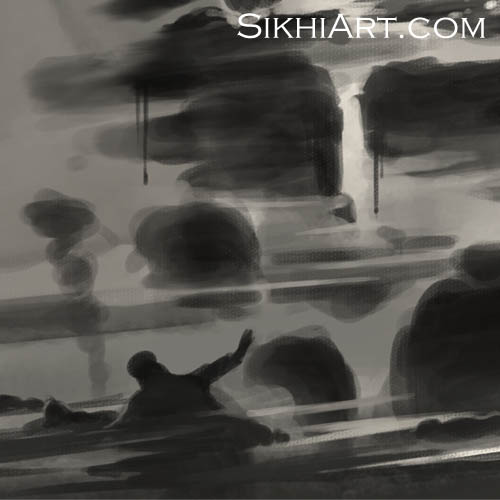
Corpse River
The Revelation of Pita Kalu ji Holding Baby Nanak
“With my eyes I look, and I see none other than Hari. My eyes are lovingly fixated, and I cannot speak of anything else.”
– Guru Angad Dev ji (Guru Granth Sahib, 655)
Pita Mehta Kalu ji looks at newly born Baby Nanak’s face, in a peaceful and serene trance state, holding him in his hands for the first time. In this painting, I wanted to paint a portrait of Mehta Kalu ji, keeping the main focus on Pita ji, while also showing the light of Guru Nanak Dev ji and his divine arrival on earth.
$59.99–$599.99 Select options
Artist’s Notes
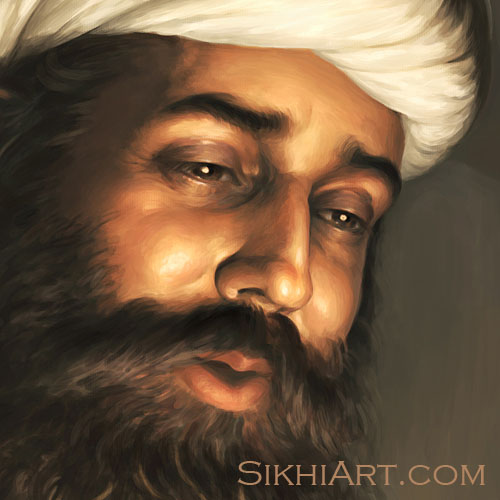
Father’s Amazement
One the of issues I was facing when painting this portrait was the identity of Pita Kalu ji. How would I paint a portrait of him and immediately have everyone know it is Mehta Kalu ji and not someone else? How would people identify him?
So I kept this question in my heart and I meditated as usual.
After several days I received my answer. As I was lying in bed, about to sleep, I had this scene of the painting come into my mind. It came to my mind, as a whole, a complete scene. In the scene, I saw Pita Kalu ji holding baby Nanak in his hands. There was no light anywhere. The only thing illuminating Pita ji was Guru Sahib himself. Guru Sahib was hidden but his light emanated from his face and lit up the room along with his father. In this manner, Guru Sahib guided me to work on this painting. Granting me the Amogh Darshan of what he wanted, all at once, such is his kindness.
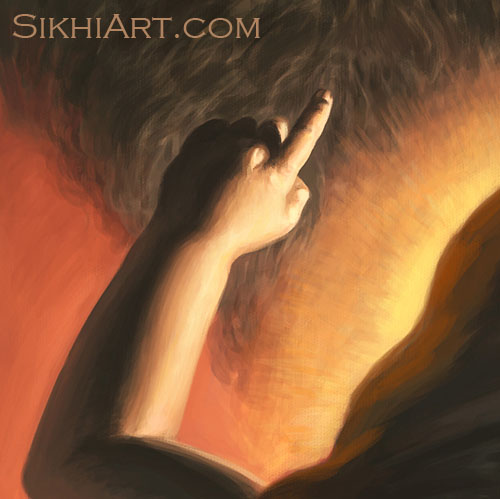
Non-Dual Oneness
Guru sahib believed in the philosophy of what is known today as Vishisht Advait, meaning Non-Dual Oneness, so holds up one finger. As Ravidas ji explains –
ਤੋਹੀ ਮੋਹੀ ਮੋਹੀ ਤੋਹੀ ਅੰਤਰੁ ਕੈਸਾ ॥ ਕਨਕ ਕਟਿਕ ਜਲ ਤਰੰਗ ਜੈਸਾ ॥੧॥
You, Me, Me, You, what is the difference? The difference is like Gold and Jewellery, like Water and Waves.
Ravidas ji says – Hey Ram! You and I, we are different but one.
Baby Nanak holds up one finger as a symbol of this state of consciousness, that is non-dual oneness, that he comes to experience and share with us later in his life.
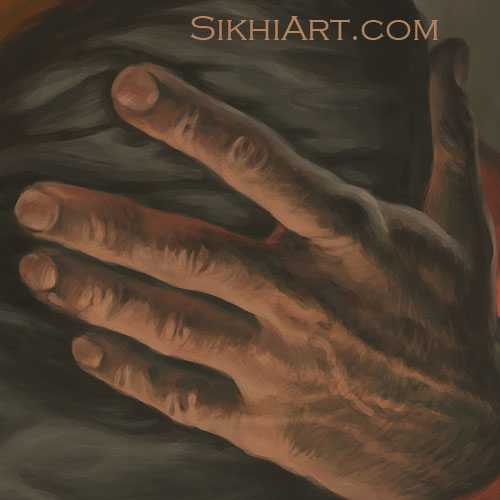
Father’s Embrace
In addition to Non-Dual Oneness, Guru Sahib preached hard work, dasan nowan di krit, work that has been done by your hands, your ten fingers. There’s a lot to be said as to why he taught it. However, in this painting I wanted to show that Mehta Kalu ji, was a hard-worker. His hands are that of a working man, who wanted to instill these ideals in his son, through whatever methods he knew, stern or otherwise.
So Pita ji’s embrace was important to show. Kalu ji holds Guru Sahib with his hands. These are the hands that helped shape Guru Sahib into the trader, the traveller and the disciplined man, just like his father. You and me, me and you; we are one, not just two.
Buy Prints »
The Story of Two Nihangs Protecting their Shrine from Demons
Bhagat Singh’s newest Fantasy Painting called – ‘Blind Chakram on Howdah’ – is a story of two Nihangs defending their Temple from blood-thirsty demons, storming through the demon hordes atop their enraged four-tusked elephant.
The main character, the wise Chakram is the one riding on the elephant’s back, in the wooden structure known as the Howdah. Behind him you can see the Temple and surrounding city under siege. The buildings are being destroyed and civilians murdered. Amongst this chaos, our Nihang hero Chakram, his Nihang partner, and his four-tusked elephant storm through the demon front lines. His elephant stomps through the horned beasts filled with rage, in a dynamic scene, while his Nihang partner impales a demon with his spear.
Chakram is blind himself and relies solely on his faith, his inner sight to guide his attacks. His tall turban serves as a high-reaching lightning rod that helps him to channel the immense power of the roaring heavens. Suddenly, in a quick flash of insight, the lightning strikes his turban and empowers him. He creates a sharp ring, known as a chakram, out of the lightning and then fires it on to the oncoming army.
‘Blind Chakram on Howdah’ is the newest paintings in a series of Sikh Fantasy Paintings by the artist Bhagat Singh. While its content is imaginary, the painting is based on spiritual ideas. It is a spiritual puzzle that is meant to be solved by the viewer.
New Edition of Hari Singh ji Nalwa
“In this age, he alone is called a warrior, who is coloured in Hari’s Love. Through the guru’s teachings, he conquers his mind, and then everything comes under his control.”
– Guru Arjun Dev ji (Guru Granth Sahib, 679)
Hari Singh Nalwa was a great general of Maharaja Ranjit Singh’s kingdom of Punjab. At a young age, while on a hunting trip, he was attacked by a tiger. With his bare hands, he pushed back the tiger, drew his sword and decapitated the beast. He was known for his excellent swordsmanship and chivalry, and his father had been serving Maharaja Ranjit Singh’s army. All of this became the deciding factors for the Maharaja to accept him in his royal service. He was given a small army of horsemen and so began Nalwa’s career as a General.
Hari Singh ji participated in the conquests of Sialkot, Kasur (1807), Multan (1818), Kashmir (1819), Pakhli and Damtaur (1821-2), Peshawar (1834) and finally Jamrud in the Khyber Hills (1837). He defeated the Afghans, something the British failed to do, and annexed a segment of what was the Kingdom of Kabul to the Sikh Kingdom in Punjab. In Peshawar, he rebuilt the Bala Hisar Fort in Maharaja’s name. He also built a chain of fortresses on his conquests to strengthen his hold. He also built one in God’s name, Haripur. This expanded the Kingdom of Punjab towards the North-west into the lands of Afghanistan, blocked off the Khyber Pass (which was pass through the mountains often used by Persian and Afghan invaders to loot and plunder Hindustan), and instilled fear of his name among the Afghan tribes.
Divine Radiance of the Adi Guru – Guru Nanak Dev ji
“My salutations to the Adi Guru, to the Guru of all ages, to the True Guru, to the Guru Lord and Master.”
– Guru Arjun Dev ji (Guru Granth Sahib, 262)
My newest painting depicting Adi Guru – Guru Nanak Dev ji – is a reminder that through the Guru’s teachings we can illuminate the darkness in the mind. In this painting, Guru Nanak Dev ji carries and radiates Akal Purakh’s light, the way the sun radiates light and warmth on us all, and when we bathe in Guru Sahib’s warmth, we become warm ourselves.
The Sun is Consciousness
Adi Guru – Guru Nanak Dev ji is a mirror to my painting of Dashmesh Pita – Guru Gobind Singh ji. Guru Nanak Dev ji is portrayed with a Sun behind him whereas Guru Gobind Singh ji is portrayed with a Moon. Guru Nanak Dev ji tells us that both the Sun and Moon are made from the same Consciousness as we are, and that through the Guru’s teachings, this can be realized intimately.
ਰਵਿ ਸਸਿ ਦੇਖਉ ਦੀਪਕ ਉਜਿਆਲਾ ॥ ਸਰਬ ਨਿਰੰਤਰਿ ਪ੍ਰੀਤਮੁ ਬਾਲਾ ॥੪॥
In the Ravi, Sun, and in the Sassi, Moon, I see my Beloved’s light, totally all-pervading, totally one with everything.
ਕਰਿ ਕਿਰਪਾ ਮੇਰਾ ਚਿਤੁ ਲਾਇਆ ॥ ਸਤਿਗੁਰਿ ਮੋ ਕਉ ਏਕੁ ਬੁਝਾਇਆ ॥੫॥
By his grace, my mind has become immersed in him. My true guru has given me this understanding of my Beloved. (Guru Granth Sahib, 223)
Spiritual Mission
The first Guru of the Sikhs, Guru Nanak Dev ji was born in Punjab, in what is now known as Nankana Sahib, situated in modern day Pakistan. From a young age, he meditated a lot and in adulthood he set out to fulfill his purpose on Earth. Already trained as a trader, he travelled and traded, all the while spreading the message of Karta Purukh. He preached that to obtain the Creator one must learn to see the Creator inside oneself through devotional meditation.
Meditation Practice
Being a poet, a meditator and a teacher, Guru Nanak Dev ji described the process of meditation using rich metaphors and vibrant imagery.
In Pauri 38 of Jap ji Sahib, he writes –
ਜਤੁ ਪਾਹਾਰਾ ਧੀਰਜੁ ਸੁਨਿਆਰੁ ॥
Your ability to withdraw your Five Senses from the world is your Workshop. Your Patience makes you a Goldsmith.
ਅਹਰਣਿ ਮਤਿ ਵੇਦੁ ਹਥੀਆਰੁ ॥
Your Intelligence is your Anvil. Following the Vedas, Sacred Spiritual Texts, is your Hammer.
ਭਉ ਖਲਾ ਅਗਨਿ ਤਪ ਤਾਉ ॥
Blow through the Pipe the Fear of God, and increase the heat of the Body.
ਭਾਂਡਾ ਭਾਉ ਅੰਮ੍ਰਿਤੁ ਤਿਤੁ ਢਾਲਿ ॥ ਘੜੀਐ ਸਬਦੁ ਸਚੀ ਟਕਸਾਲ ॥
In your container of Love, pour in the molten gold that is Amrit, Timeless Quality of Consciousness, and mint the Gold coins of your Guru’s teachings.
ਜਿਨ ਕਉ ਨਦਰਿ ਕਰਮੁ ਤਿਨ ਕਾਰ ॥ ਨਾਨਕ ਨਦਰੀ ਨਦਰਿ ਨਿਹਾਲ ॥੩੮॥
Those who are looked upon kindly by their Guru, they find out how to do this method. And when they apply the method, they are liberated. (38)
Meditation is a process of withdrawing the senses from worldly distractions, and going inwardly with utmost patience and equanimity. In this timeless state of consciousness, you impress upon the intelligence of the mind, the teachings of the Guru and the Vedas, Spiritual Texts, to create something valuable, that is the minting of Gold Coins. The ‘Fear of God’ means to pay attention intensely and be awake and aware. This naturally increases bodily heat as many people who meditate sometimes notice.
Guru Sahib is describing a more advanced meditation practice however the whole process becomes easier when it is performed with love and devotion.
The Guru’s Teaching is Nourishment for the Soul
In this way, Guru Nanak Dev ji looks inwardly and sees the light of God inside, and he radiates this light into our lives through his teachings. He nourishes our soul the way the sun nourishes the trees, plants and all the greenery in the painting. He brings peace to our hearts and gives us wholesome rest in this tiresome world.
















